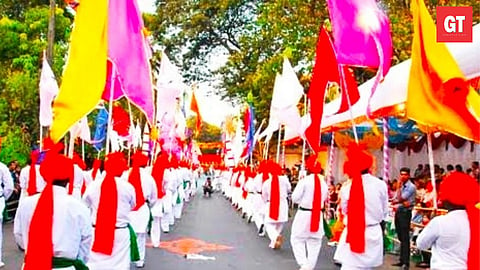

Shigmo isn't merely a riot of colour, but includes many dance forms, too
Gomantak Times
Shigmo is essentially a festival of the farming community, celebrating the arrival of new crop. This festival, marked by song and dance is celebrated in Spring.
Ganesh Chaturthi and Shigmo (a religious and folk festival respectively) are two of the most important festivals of Goa’s Hindus.
Shigmo happens during the month of Phalgun – the month proclaiming the arrival of spring. Shigmo is also the Konkani name of the month of Phalgun, the last month of the Hindu calendar. Like Holi, the festival begins on Phalgun Poonav (full moon) day. But unlike Shigmo, which is celebrated till the last day of Phalgun (or even beyond), Holi is a one-day festival. The celebrations spill onto the streets, public places, temples and at the mand.
The Ghode Modni dance is easy to recognise, with its characteristic horse costumes
PIC COURTESY: JoeGoaUk
SONG & DANCE
Groups of dancers are called mel, on one side, and rombat on the other. In rombat, besides the dhol and tabla, huge drums (nagara and jaghant) are played. People of all ages, decked in colourful robes, join the mel/rombat, dancing to the drums beats, and accompanied by adabgiris (ornamental umbrellas) and other objects, which were formerly used by royalty.
Each mel/rombat carries its own colour ie the traditional flag colour. They carry the gudhi – a sacred flagstaff – and decorations with respect and pride. The dancers wear flowers in their necks, hands and turbans.
The mel begins with the invocation to the manda guru and the main deity, followed by the subordinate deities of the village, who protect it. This invocation is known as naman, and is an invitation to them to join the Shigmo celebrations.
Goff is a dance where a kind of rope is created via some fancy footwork
Gomantak Times
SHIGMO DANCES
After the naman, the mel proceeds in a procession to the temple of the main deity. It culminates at the temple premises and a short performance takes place. After partaking of the prasad, the mel goes from house to house in the village via a fixed traditional route.
The dancers present a variety of folk songs, depicting Hindu mythological stories, social aspects and Mother Nature. They also perform in the neighbouring villages.
On a particular day, many mel from nearby villages assemble at one temple. The dances performed are the same all over Goa, like Taalgadi, Tonya Mel, Goff, Chowrang, Jot, Sakarat, Ghode Modni, Romat, Samayi, Morulo, Talo, etc.
The Samayi dance, involves a balancing act using lighted brass lamps
Gomantak Times
Both, Hindus as well as Christians, dance the Taalgadi. Taal means rhythm and gadi means ‘man’. Shigmo is an opportunity to showcase diverse facets of Goan folk art. Traditionally, certain villages in Goa developed distinct folk dances.
The Ghode Modni, of Bicholim, depicts the expedition of the Ranes against the Portuguese.
The Rombat reminds one of the good old days when every village was virtually a republic. Rombats are processions which are held from one village to the boundary of the neighbouring village, where the two processions meet and exchange greetings and collectively pray for the welfare of both villages.
Tonya Mel is seen all over Goa.
The Morulo dance mimics the movements of a peacock
Gomantak Times
Goff is another dance form in which the dancers weave and unweave silken ropes, forming lovely, colourful patterns. The coloured ropes are tied at the top of a pole and well-rehearsed steps are executed by the dancers, to get the desired effect of the rope.
In the Samayi dance, lighted brass lamps are balanced on the head and are carried gracefully throughout the dance.
The Morulo dance depicts the movements of a peacock.
Ranamale, a dance drama, based on the Ramayana, is performed in Sattari.
On the last day of Shigmo, there is an assembly at the mand to bid adieu to the deities. People sing and dance to the beat of traditional percussion instruments such as the dhol, tasha and jaghant, and the performance goes on well into the night.